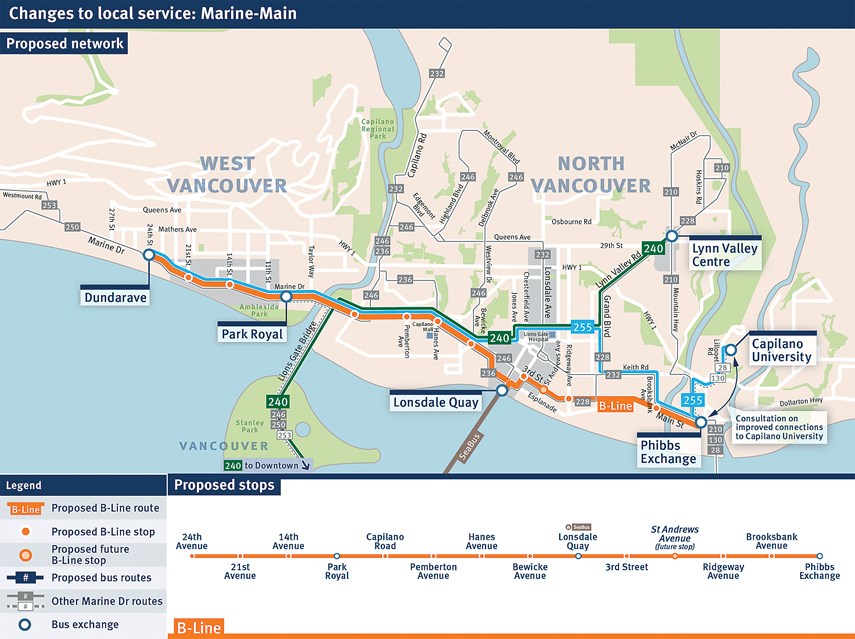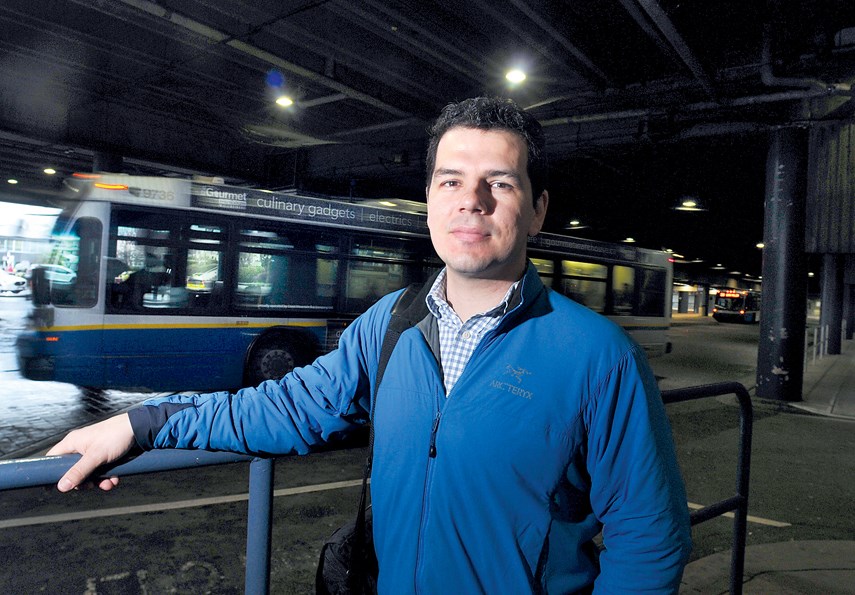Inquiring minds at TransLink want to know: should we scrap some on-street parking to make a B-Line bus service run faster? What about restricting left-hand turns so buses don’t get stuck behind turning cars? Is it worth four extra minutes to get transit commuters dropped off right at the SeaBus?
Those are some of the questions the public is being asked to weigh in on by the transit authority this month, as plans are put in place to roll out a new B-Line bus service for the North Shore next year.
TransLink is planning to launch a fast B-Line bus route in 2019 which would run from Dundarave in West Vancouver to Phibbs Exchange in North Vancouver.
The route will use high-capacity articulated buses, from 6 a.m. to 1 a.m., and will run every 10 minutes during the day, and every eight minutes at rush hour.
Someone taking the B-line from one end to the other should be able to do the trip in 45 minutes – 15 minutes faster than it’s possible on public transit currently.
“When you compare it to driving in a car not in rush hour it doesn’t sound that fast,” acknowledges District of North Vancouver Coun. Mathew Bond.
But he adds most people taking the B-line probably won’t be taking it all the way. The new bus will also provide a faster service between many stops along the way – like from Lower Lonsdale to Phibbs or from Lonsdale Quay to Capilano Mall.
Those trips will all be “a lot faster and more convenient for people,” said Bond.
But to keep the wheels of the bus rolling at a faster clip, there are likely to be trade-offs.

If the B-line is to make a real impact on the way people get around on the North Shore “it needs to be quick, convenient and it needs to be easy,” said Bond. “The way to do that is to give a bus a dedicated lane.”
“That might mean in some areas taking away parking,” he said. “It might mean some changes to the traffic patterns.”
It’s a complex discussion, Bond said. Generally, businesses aren’t in favour of taking away parking. But if doing that means bringing more people directly to the neighbourhood where the business is located, some concerns might be alleviated, he said.
Similarly, limiting turn lanes might upset vehicle drivers while winning points with those getting a faster bus ride.
Bond said a detailed discussion won’t be possible until transit planners know what the impacts of any potential changes might be. But he said some of those issues may involve making hard choices.
“If we’re trying to make transit at least competitive as a way for people to move around the North Shore, these are the kinds of decisions we’re going to have to make.”
Last fall, North Vancouver-Seymour MLA Jane Thornthwaite floated the idea of a rapid transit line across the North Shore.
Bond says it’s an interesting idea, but communities which have or are getting rapid transit – like Vancouver and Surrey – have had to contribute significant money to the project as well as commit to levels of housing density unlikely to get off the ground on the North Shore.
In contrast, “a B-line with a dedicated lane gives you almost that level of service for an order of magnitude less the cost,” he said.
There are 14 proposed stops for the North Shore B-line route. TransLink is asking the public’s opinion on whether there should be more stops, or fewer of them.
Planners also want to know whether riders would prefer to see the bus drop down to bring riders directly to the SeaBus – which is currently in the plan, and adds four minutes to the trip – or whether the bus should continue straight down Esplanade.
Changes to other bus routes will also be put in place in conjunction with the B-line next year.
Service will run more frequently on some of the more popular routes and those connecting with hubs like Capilano University. Other routes being duplicated by the B-line route will likely be reduced.
The public survey on the B-line runs online until May 31 at translink.ca/bline.



